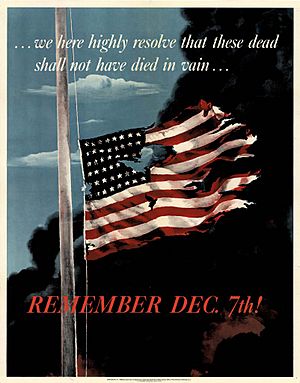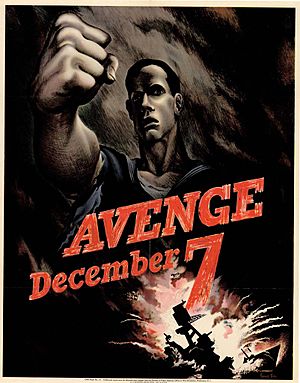Day of Infamy speech facts for kids
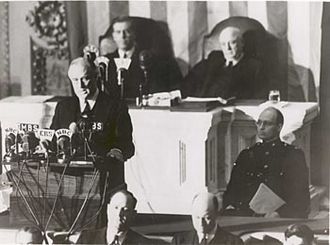
Franklin D. Roosevelt delivering the speech to the Congress
|
|
| Date | December 8, 1941 |
|---|---|
| Duration | approximately 6.5 minutes |
| Venue | United States Capitol |
| Location | Washington, D.C. |
| Type | Speech |
| Participants | President Franklin D. Roosevelt |
| An excerpt from the speech where Roosevelt says "... a date which will live in infamy". | |
The "Day of Infamy" speech was given by Franklin D. Roosevelt, the 32nd president of the United States. He delivered it to a special meeting of Congress on December 8, 1941. This was the day after the Empire of Japan attacked United States military bases at Pearl Harbor, Hawaii, and the Philippines. Japan also declared war on the United States and the British Empire. The speech is famous for its first line: "Yesterday, December 7, 1941—a date which will live in infamy..."
On Sunday, December 7, 1941, the American naval base at Pearl Harbor in Hawaii was attacked. About 353 Japanese planes launched a surprise military strike. They destroyed many American ships and aircraft. Over 2,400 people, both civilians and military, were killed. After talking with his advisors, President Roosevelt decided to speak to Congress the next day.
Roosevelt's speech was carefully written. It showed the United States as a victim of Japan's attack. It also encouraged feelings of patriotism (love for one's country). The speech was very powerful because it was given at just the right moment. It quickly united the country.
The speech had a huge and lasting impact. It is one of the most famous speeches in American history. It was broadcast live on radio and reached a very large audience. Over 81% of Americans listened to it. Soon after the speech, Congress almost completely agreed to declare war against Japan. The White House received many messages praising Roosevelt. The speech has also been used in many films. Roosevelt's words, "a date which will live in infamy," are often compared to other important dates. These include November 22, 1963 (the assassination of John F. Kennedy), September 11, 2001 (the September 11 attacks), and January 6, 2021 (the attack on the U.S. Capitol).
Contents
The Attack on Pearl Harbor
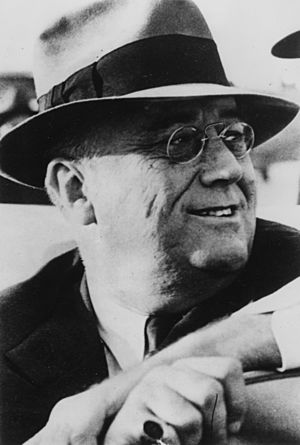
Franklin D. Roosevelt was born in 1882 in New York. He first worked as a lawyer. Later, he became a member of the New York State Senate. He also served as the assistant secretary of the Navy. In 1932, he was elected president. He won again in 1936 and 1940, serving an unusual third term.
On December 7, 1941, the Japanese attacked Pearl Harbor. This was a naval base in Hawaii. The attack happened at 7:48 a.m. Hawaii time. About 350 American aircraft and 21 ships were destroyed. More than 2,400 people died.
President Roosevelt learned about the attack shortly after 1:00 p.m. Eastern time. He was having lunch at the time. The Secretary of the Navy, Frank Knox, called him. He said: "Air raid on Pearl Harbor. This is not drill." Roosevelt quickly ordered all military personnel to get ready. His secretary said the attacks happened "wholly without warning." This was true even though both countries were at peace.
Japan's declaration of war was delayed. It arrived 30 minutes after the attack began. Roosevelt talked with his advisors and members of Congress. He told them not to blame anyone. Instead, they should focus on the fact that the United States was now "in it." The British Prime Minister, Winston Churchill, called Roosevelt. He said: "We are all in the same boat now."
Roosevelt had polio and used a wheelchair. But he was known as a very good speaker. He worked hard on his speeches. He would provide the main ideas he wanted to include. Then, he would make sure the speech was the right length and had the right tone. Roosevelt decided to give his speech to Congress the very next day. The attack gave him a clear goal and direction.
Roosevelt's Speech to Congress
The "Infamy Speech" was short, lasting about 6 minutes and 30 seconds. Roosevelt gave it to Congress at 12:30 p.m. on December 8, 1941. His Secretary of State, Cordell Hull, suggested he talk more about the history of Japanese-American relations. He also wanted Roosevelt to explain the efforts to find a peaceful solution. However, Roosevelt kept the speech brief. He believed a shorter speech would have a stronger effect.
Roosevelt's final speech was very powerful. It strongly insisted that history would agree with America's view of the attack. It was not just Roosevelt's personal feelings. It was a statement from all Americans facing a difficult time. The speech helped to unite the nation and guide its response.
The first part of the speech showed the United States as a victim. An early draft said, "a date which will live in world history." Roosevelt changed it to "a date which will live in infamy." He used a special way of speaking. Instead of saying "Japan attacked the United States," he said "the United States of America was suddenly and deliberately attacked." This made America's role as a victim stand out. Roosevelt said:
Yesterday, December 7, 1941—a date which will live in infamy—the United States of America was suddenly and deliberately attacked by naval and air forces of the Empire of Japan.
The United States was at peace with that Nation and, at the solicitation of Japan, was still in conversation with its Government and its Emperor looking toward the maintenance of peace in the Pacific. Indeed, one hour after Japanese air squadrons had commenced bombing in the American Island of Oahu, the Japanese Ambassador to the United States and his colleague delivered to our Secretary of State a formal reply to a recent American message. And while this reply stated that it seemed useless to continue the existing diplomatic negotiations, it contained no threat or hint of war or of armed attack.
Roosevelt pointed out that Japan was far from Hawaii. This made it clear the attack was planned "days or even weeks ago." He also mentioned that diplomatic talks were still happening with Japan. He said Japan was being dishonest by secretly preparing for war. He wanted to avoid the kind of speech President Woodrow Wilson gave in 1917. Wilson's speech focused on big ideas about making the world better. But in the 1930s, Americans did not like these ideas as much. They were careful about getting involved in wars to change the world.
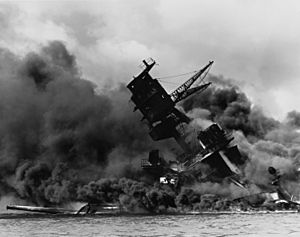
Roosevelt chose to appeal to people's feelings of patriotism. He wanted them to feel a strong love for their country. He also made a symbolic connection to the 1917 declaration of war. He was joined by Edith Bolling Wilson, President Wilson's widow.
The idea of "infamy" in the speech was powerful. It was like other times America had faced big defeats, such as the Battle of the Little Bighorn or the sinking of the USS Maine. These events also caused strong anger and a desire to fight back. Defeats were shown as steps toward an eventual victory. Roosevelt's speech followed a tradition where presidents gain special powers as commander-in-chief. It helped unite the nation under God. Roosevelt used the idea of kairos, which means speaking at the perfect moment. This made his speech very important. By speaking the day after the attack, Roosevelt showed he was ready to face the problem. This showed its importance to him and the country.
Roosevelt also stressed that "our people, our territory and our interests are in grave danger." He mentioned reports of Japanese attacks in the Pacific. He wanted to stop the isolationist movement. This group had argued against America joining the war in Europe. He ended the speech by saying:
No matter how long it may take us to overcome this premeditated invasion, the American people in their righteous might will win through to absolute victory. I believe that I interpret the will of the Congress and of the people when I assert that we will not only defend ourselves to the uttermost but will make it very certain that this form of treachery shall never again endanger us. Hostilities exist. There is no blinking at the fact that our people, our territory, and our interests are in grave danger. With confidence in our armed forces—with the unbounding determination of our people—we will gain the inevitable triumph—so help us God. I ask that the Congress declare that since the unprovoked and dastardly attack by Japan on Sunday, December 7, 1941, a state of war has existed between the United States and the Japanese Empire.
Impact and Legacy
Roosevelt's speech had an immediate and lasting impact. It is considered one of the most famous speeches in American politics. Thirty-three minutes after he finished speaking, Congress declared war against Japan. Only one Representative, Jeannette Rankin, voted against it. The speech was broadcast live on radio. It had the largest audience in American radio history, with over 81% of people listening.
The response was very positive, both in Congress and across the country. An advisor to Roosevelt, Samuel Irving Rosenman, described the scene in Congress as "the most dramatic spectacle." He said that Democrats and Republicans worked together. There was a new feeling of unity and a shared goal to see things through. This was happening all over the country.
The White House received many messages praising Roosevelt. One person wrote: "On that Sunday, we were dismayed and frightened, but your unbounded courage pulled us together." Many people rushed to join the military. Recruiting stations were open 24 hours a day to handle the crowds. The number of volunteers was twice as high as after World War I. The anti-war movement also ended after the speech. Even Roosevelt's biggest critics supported him. Charles Lindbergh, who had been against the war, supported the speech. He said: "Our country has been attacked by force of arms, and by force of arms we must retaliate."
The famous line is often misquoted as "a day that will live in infamy." But Roosevelt emphasized the date—December 7, 1941—not just the day of the week. He wanted to highlight the historical importance of the Pearl Harbor events. He wanted Americans to never forget the attack and its date. The phrase "day of infamy" is now used to describe any moment of great disgrace or evil.
Roosevelt's way of describing the Pearl Harbor attack became the standard American story of December 7, 1941. Hollywood movies used this story. Films like Wake Island (1942) and Air Force (1943) included real radio reports. These reports talked about the talks with Japan before December 7. This helped show the enemy's dishonesty. Other movies also used newspaper headlines to show how relations with Japan changed. The idea of America being innocent but betrayed was also often shown in movies.
Roosevelt's words about December 7, 1941, living in infamy came true. The date became a short way to refer to the Pearl Harbor attack. It is like how November 22, 1963, means the assassination of John F. Kennedy. And September 11, 2001, means the September 11 attacks. The slogans "Remember December 7th" and "Avenge December 7" became popular rallying cries. They were on posters and pins. A film called Prelude to War (1942) told Americans to remember September 18, 1931. This was the date of the Japanese invasion of Manchuria. The film said this date was as important as December 7, 1941, because the war started then.
The speech's impact was still felt after the September 11 attacks. Many people compared those attacks to Pearl Harbor. President George W. Bush's administration tried to connect September 11, 2001, to the Pearl Harbor attack. They used ideas and language from Roosevelt's "Infamy Speech." Bush's speech on September 11, 2001, called the attacks "evil, despicable acts of terror." He compared them to America, which he called a "beacon for freedom." Some people also used World War II terms, like "Axis of Evil," to describe America's enemies.
In 2004, Spanish Prime Minister José María Aznar mentioned the speech. He did this after the 2004 Madrid train bombings. He said, "On March 11, 2004, it already occupies its place in the history of infamy." In 2021, after the attack on the Capitol, Senator Chuck Schumer added that date to the "very short list of dates in American history that will live forever in infamy."
Images for kids
See also
 In Spanish: Discurso de la infamia para niños
In Spanish: Discurso de la infamia para niños




